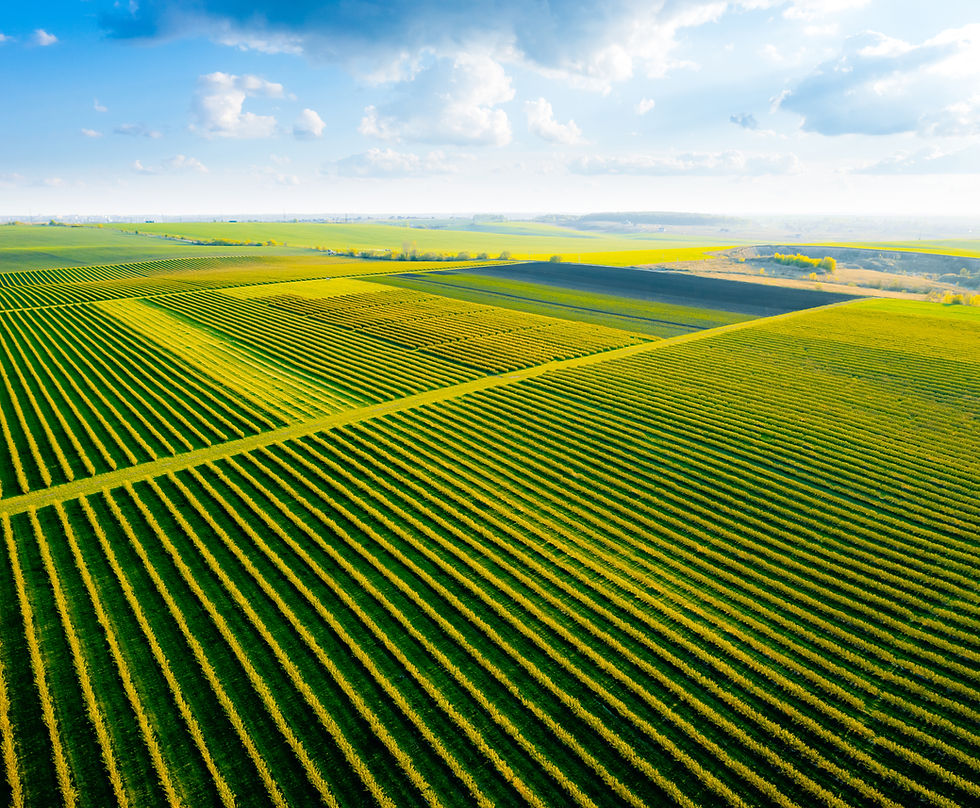Cultivating Efficiency: Exploring Diverse Uses of Drones in Agriculture
- Emily Adams

- Apr 5, 2024
- 3 min read
Updated: Apr 8, 2024
In the dynamic realm of agriculture, technology continues to revolutionize traditional farming methods, fostering efficiency, sustainability, and precision. Drones, or Unmanned Aerial Vehicles (UAVs), stand at the forefront of this transformation, offering a plethora of applications that extend far beyond conventional practices. In this blog, we'll delve into the multifaceted uses of drones in agriculture, from precision mapping and crop monitoring to wildlife management and research, highlighting their pivotal role in shaping the future of farming.

Aerial Imaging and Crop Monitoring
One of the primary applications of drones in agriculture is aerial imaging and crop monitoring. Equipped with high-resolution cameras and sensors, drones capture detailed aerial imagery of farmland, enabling farmers to monitor crop health, detect early signs of disease or nutrient deficiencies, and assess overall plant vigor. By analyzing aerial imagery, farmers can make data-driven decisions regarding irrigation, fertilization, and pest management, optimizing crop yields and reducing input costs.

Wildlife Management and Predator Population Monitoring
In addition to crop-centric applications, drones are increasingly utilized in wildlife management efforts. Equipped with thermal imaging cameras and GPS tracking technology, drones facilitate the monitoring of predator populations, enabling farmers to mitigate conflicts and protect livestock from predation. Aerial surveys conducted by drones provide valuable data on wildlife movements, behavior, and habitat usage, informing conservation strategies and promoting coexistence between agriculture and wildlife.

Field Surveying and Precision Mapping
Drones play a vital role in field surveying and precision mapping, providing farmers with detailed insights into soil composition, topography, and drainage patterns. Using LiDAR technology and high-resolution cameras, drones generate accurate 3D maps of farmland, enabling farmers to identify areas with varying soil fertility and moisture levels. This information allows farmers to implement precision agriculture techniques, such as variable rate application of inputs and targeted soil amendments, to optimize resource utilization and maximize crop productivity.

Irrigation Management and Water Conservation
Efficient water management is essential for sustainable agriculture, particularly in regions prone to water scarcity. Drones equipped with multispectral sensors and thermal cameras assess crop water stress levels and identify areas with inadequate irrigation coverage. By providing real-time data on crop moisture levels and irrigation needs, drones help farmers optimize irrigation scheduling, minimize water usage, and maximize water efficiency. Additionally, drones detect leaks or inefficiencies in irrigation systems, enabling proactive maintenance and conservation efforts.
Prescription Mapping and Precision Agriculture
Prescription mapping is a key component of precision agriculture, allowing farmers to tailor management practices to specific field conditions. Drones equipped with remote sensing technology, such as multispectral and hyperspectral cameras, collect data on crop health, nutrient levels, and soil properties. This data is analyzed using precision agriculture software to generate prescription maps, guiding farmers in the precise application of inputs, such as fertilizers and pesticides, based on localized needs. By optimizing input usage and minimizing environmental impact, prescription mapping enhances productivity and sustainability in agriculture.

Livestock Management and Monitoring
Beyond crop-centric applications, drones are valuable tools for livestock management and monitoring. Thermal imaging cameras mounted on drones enable farmers to conduct aerial surveys of their herds, assess animal health and behavior, and identify potential issues such as injury or illness. By monitoring livestock from above, farmers can implement proactive measures to ensure animal welfare, optimize grazing patterns, and prevent livestock losses due to predation or disease.
Embracing Drone Technology in Agriculture
As drones continue to evolve and innovate, their role in agriculture expands, offering a diverse range of applications that enhance productivity, sustainability, and resilience. From crop inspection and wildlife management to field surveying and irrigation optimization, drones empower farmers to make informed decisions, implement precision agriculture techniques, and manage natural resources more efficiently. By embracing drone technology and leveraging its capabilities, agriculture enters a new era of innovation, efficiency, and sustainability.



